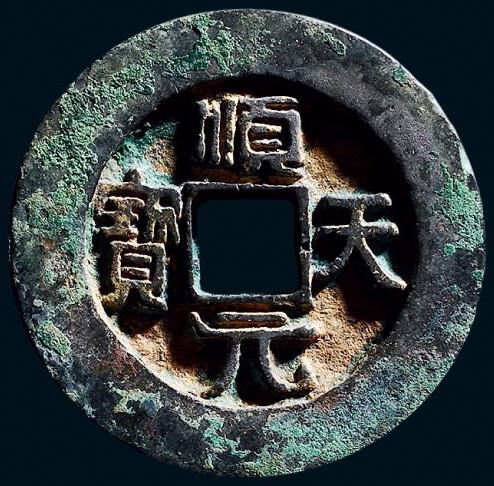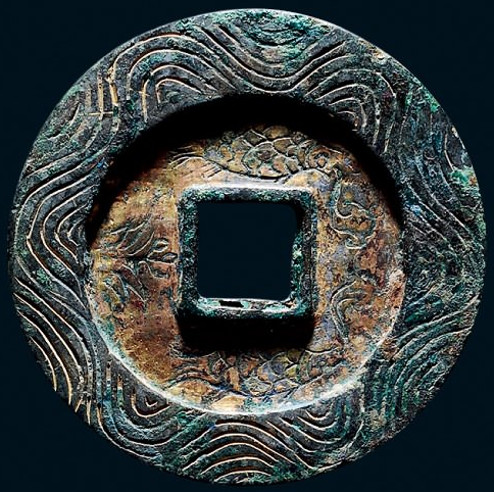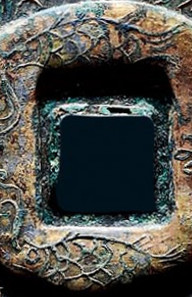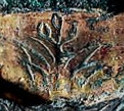This beautifully engraved and gilded shun tian yuan bao (顺天元寶) charm dating from the Tang Dynasty (唐朝) appeared at an auction in China in 2015.
Shun tian yuan bao coins were issued during the years 759-761 by Shi Siming (史思明), a rebel leader who seized control of the Tang dynasty capital of Luoyang (洛阳). Luoyang was a major center of Buddhism (中国佛教) in ancient China.
Shun tian (顺天) refers to the Shi Siming’s era name.
The shun tian yuan bao was the first coin to use the term yuan bao (元寶) meaning “original currency”.
The character bao (寶), at the left of the square hole, is written in the same style as used on the kai yuan tong bao (開元通寶) coins of the Tang dynasty. The yuan (元) character, below the square hole, has a left shoulder similar to the majority of kai yuan tong bao coins.

Shun Tian Yuan Bao gilded charm
The obverse side, shown above, is the same as a standard shun tian yuan bao coin. The only difference is that this coin is slightly larger. The diameter is 39.7 mm while most of the coins are 36.5 – 37.5 mm. Because of its size, this coin may have been an early issue.
Shown below is the reverse side.

Bat, fish and lotus symbols on reverse side of Shun Tian Yuan Bao charm
As can be clearly seen, the reverse side of this coin has been embellished and gilded (鎏金). The broad rim has been engraved with a wave-like pattern and the area surrounding the center hole has four symbols making the coin into a charm.
The description in the auction catalogue describes the charm as being exquisitely engraved with waves and “auspicious cloud” symbols, and that it was probably an offering to a Buddhist temple during the Tang dynasty.
However, upon careful examination it can be seen that the so-called “auspicious clouds” (祥云) are in fact something quite different.

The bat implies good fortune and happiness
I have rotated the coin so that the symbols can be viewed more easily.
Shown at the left is the symbol at the right of the hole. The symbol is actually that of a bat with its wings spread.
The bat is considered an auspicious symbol to the Chinese because its pronunciation fu (蝠) is the same as the pronunciation of the Chinese word fu (福) which means “good fortune” or “happiness”.
The bat symbol is therefore a “visual pun” or rebus for “good fortune”.
(Please see Bat Open Work Charm for a more in-depth discussion of the bat symbol.)

Fish symbols above and below the square hole
Rotating the charm 180 degrees, the symbols above and below the square hole can more easily be identified.
As can be clearly seen, there is a fish above and a fish below the square hole.
The fish symbol is frequently seen on Chinese charms because it also serves as a visual pun.
The Chinese character for fish is 鱼 which is pronounced yu.
The Chinese word for “abundant” (余) is also pronounced yu.
The fish symbol therefore means “more” as in “more happiness” or “more good fortune”.
The depiction of two fish takes on an additional meaning. Because fish lay many eggs, its reproductive abilities is a symbol of fertility in marriage. Having many sons was particularly important to the ancient Chinese because of the importance of ancestor worship.
A pair of fish (shuang yu 双鱼) can also represent happiness in marriage.
The fish symbol can also be seen on other ancient Chinese coins. A fine example is this zhi bai wu zhu (“Value One Hundred Wu Zhu” 直百五铢) coin issued in 214 AD by Liu Bei (刘备) who founded the State of Shu (蜀汉) during the Three Kingdoms period (三国) AD 220-280.
(For a more detailed discussion of the fish symbol, please see Fish Charms.)

The lotus
The final symbol on the reverse side is shown at the left.
This is a lotus (lian hua 莲花 or he hua 荷花).
The lotus is an important Buddhist symbol signifying purity and enlightenment.
Additionally, the Chinese character 莲 (lian) for lotus has the same pronunciation as 连 (lian) meaning “continuous”. A lotus therefore also implies that good fortune and happiness should continue forever.
In regard to fertility, the 莲/连 pun implies that boy babies will be born one after another.
As mentioned above, the Chinese character 荷 (he) also means lotus. This character has the same pronunciation as 和 (he) meaning “harmony”. The lotus thus also has the hidden meaning of harmony in marriage.
(For a further discussion of the lotus symbol, please see a Lotus Open Work Charm.)
This beautifully engraved and gilded shun tian yuan bao charm sold at auction in 2015 for about $5,243 (RMB 34,500).